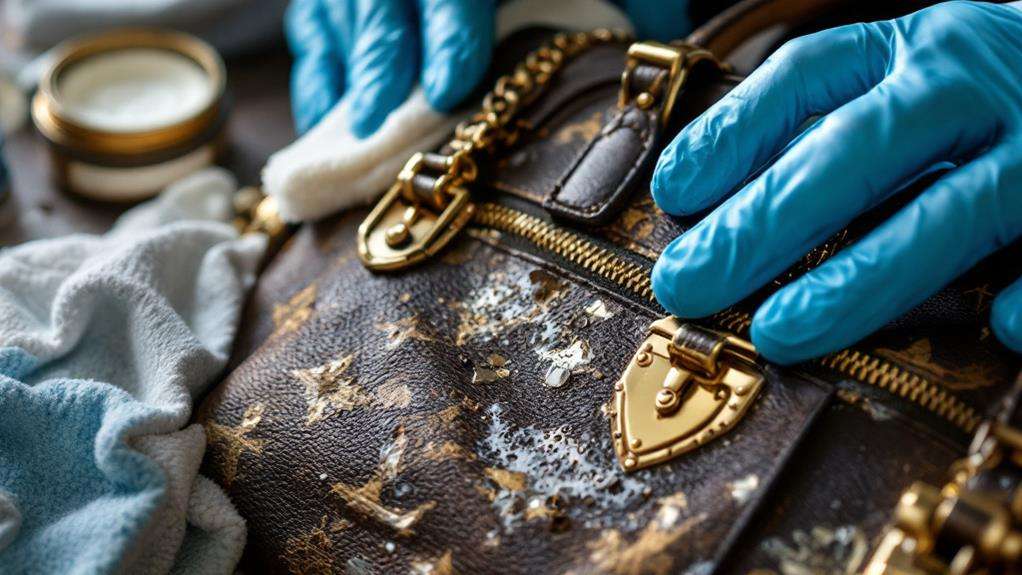What Is the Oldest Known Handbag?
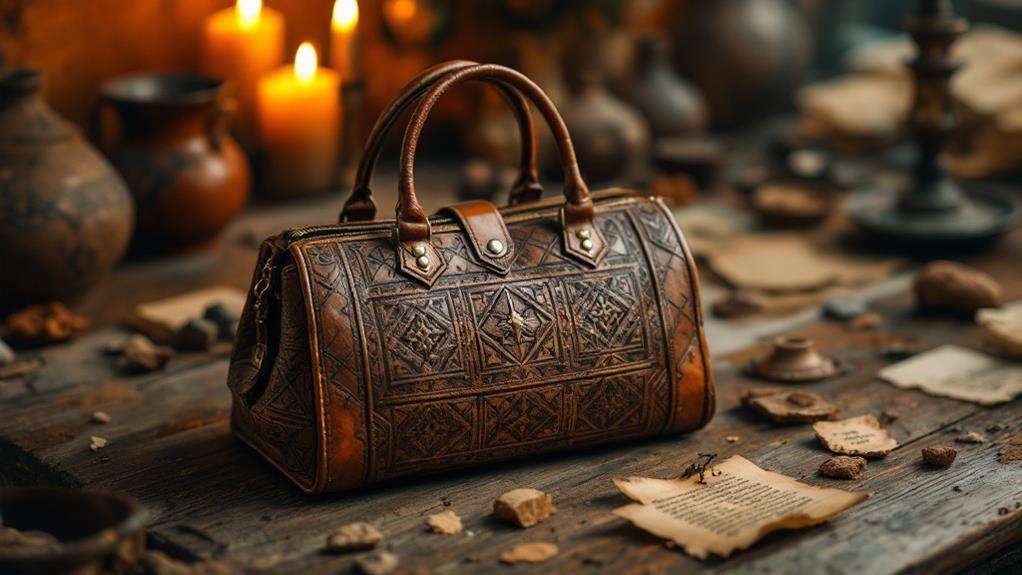
The oldest known handbag is the Courtauld Bag, crafted around 1300-1330 A.D. in Mosul, Iraq, during the Ilkhanate period. Made from brass inlaid with gold and silver, this exquisite piece highlights the artistic brilliance of the time. Initially mistaken for a man's work basket, it was later recognized as a woman's purse, illustrating the deep cultural significance and status associated with such items. Its intricate court scene and Arabic inscriptions provide a glimpse into historical social hierarchies and cultural practices. Uncover how this artifact bridges past and present with its artistic and social narratives.
Ancient Origins of Handbags
Handbags, a staple in fashion today, have surprisingly ancient origins that trace back over 700 years. Imagine the oldest surviving handbag, which dates back to around 1300 A.D., during the Ilkhanate period in Mosul, Iraq. This remarkable artifact, known as the Courtauld Bag, provides a fascinating glimpse into the history of fashion accessories. Crafted from five sheets of brass inlaid with gold and silver, the handbag features an intricate court scene and a rhyming Arabic inscription, depicting a royal couple. The craftsmanship and luxury materials highlight its significance in the social context of the time.
Initially misidentified by scholars as a man's work basket or saddlebag, the Courtauld Bag's true identity as a woman's purse reveals the sophistication and status associated with handbags even in ancient times. It's believed to have belonged to an Ilkhanid noblewoman, showcasing how handbags were already integral to one's attire. The minimal wear and remarkable preservation suggest it may have been a rare diplomatic gift. This revelation underscores the long-standing tradition of using handbags not just for practicality, but also as symbols of elegance and status, even during the Ilkhanate period.
Discovery of the Courtauld Bag
In a fascinating turn of historical revelation, the Courtauld Bag, dating from approximately 1300-1330 A.D., emerged as a remarkable artifact from the Ilkhanate age in Mosul. This exquisite piece is recognized as the oldest known surviving handbag in the world. Acquired by Thomas Gambier Parry in 1858, the bag was initially mistaken for other objects, such as a man's work basket or saddlebag. However, scholarly research and exhibitions at the Courtauld Institute of Art have redefined its identity, confirming it as a handbag.
When exploring the significance of the Courtauld Bag, consider the following:
- Historical context: It's a product of the Ilkhanate rule, reflecting the cultural and artistic influences of Mosul during a time of rich historical tapestry.
- Unique design: The bag features a court scene with a rhyming Arabic inscription showing a royal couple, offering insights into the age's social and artistic expressions.
- Artistic evolution: Its revelation highlights the evolution of handbags and their roles in society, from decorative accessories to practical utilities.
This revelation not only enriches our understanding of historical fashion but also illuminates the sophisticated craftsmanship of its time.
Material and Craftsmanship
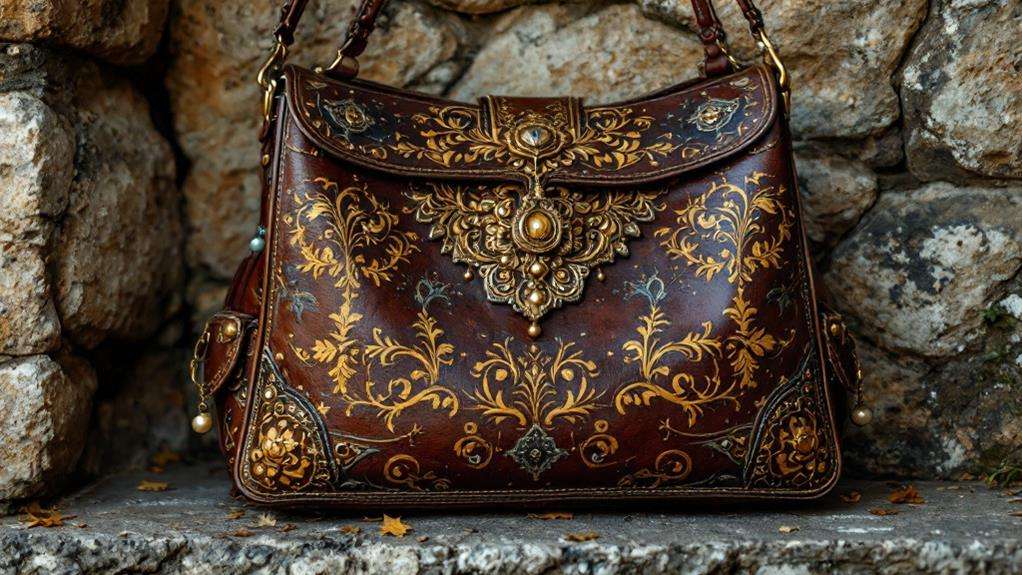
Crafted from brass with intricate inlays of gold, silver, and a mysterious black material, possibly bitumen or resin, the Courtauld Bag exemplifies the advanced metalworking techniques of its age. This handbag made under the Ilkhanate rule in Mosul around 1300-1330 showcases exceptional craftsmanship. You can see how the artisans skillfully combined five brass sheets, either soldered or hinged, to create a seamless structure. The detailed inlays of gold and silver highlight their expertise in metalwork, a reflection of the time's artistic achievements.
When examining the handbag, you'll notice the original strap rings were likely larger. This detail suggests that the smaller existing rings might not have been practical for everyday use, hinting at a ceremonial or decorative purpose. It's fascinating to think about the hands that carefully inlaid gold and silver into the brass, transforming raw materials into a masterpiece.
Moreover, the exterior court scene adorned with a rhyming Arabic inscription reflects the cultural richness of the period. It's a piece that not only demonstrates skilled craftsmanship but also speaks volumes about the time's artistic and cultural values. Preservation of such metal artifacts is rare, making this handbag even more remarkable.
Historical Significance
The Courtauld Bag isn't just a demonstration of exquisite craftsmanship; it's a window into the past, illuminating the cultural dynamics of the Ilkhanate epoch. As the oldest surviving handbag, made in Mosul between 1300 and 1330 A.D., it holds immense historical significance. This brass handbag, intricately inlaid with gold and silver, not only showcases the artistic genius of the time but also reveals the blending of Islamic art with Mongol influences. Its existence offers a rich narrative about the epoch's societal structure, particularly the roles and status of noblewomen.
You can uncover several fascinating insights by examining this handbag:
- Cultural Intersection: The handbag epitomizes the fusion of different artistic traditions, highlighting how artisans adapted to the cultural shifts during the Ilkhanid dynasty.
- Women's Roles: It challenges preconceived notions about women's public roles, suggesting noblewomen of the time had a more pronounced societal presence than previously thought.
- Artisan Expertise: The craftsmanship points to the advanced skills and techniques prevalent in Mosul, emphasizing the city's role as a cultural and artistic hub.
Misidentification and Reassessment
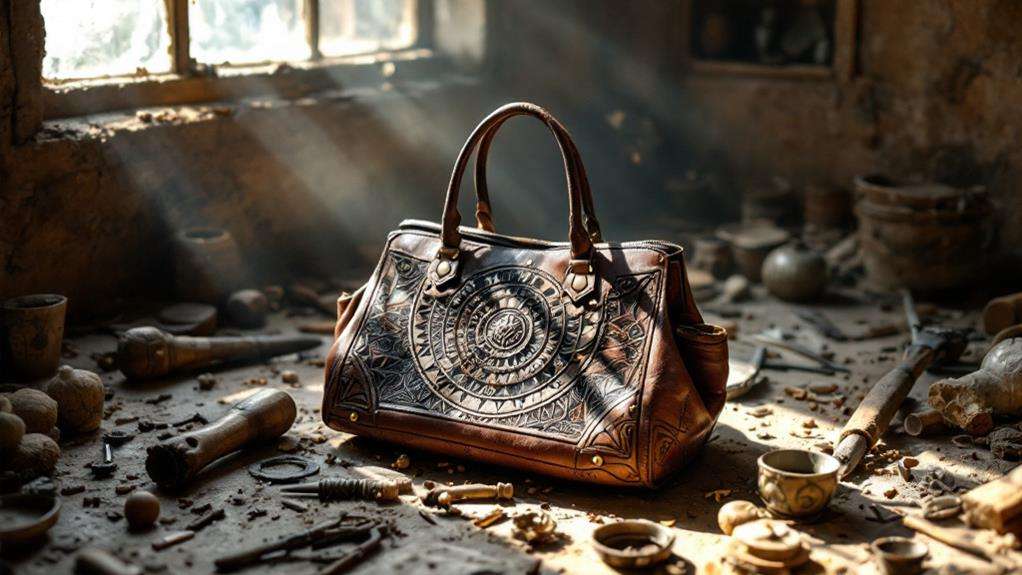
Often, historical artifacts like the Courtauld Bag undergo misidentification, which can obscure their true significance. Initially thought to be a man's work basket, document wallet, or even a saddlebag, this artifact was misunderstood by academics for years. It wasn't until a reassessment of its design and context that scholars recognized it as a woman's handbag. This revelation not only reshaped our understanding of the artifact but also highlighted the importance of accurate identification in appreciating historical objects.
You might wonder why such misidentifications occur. Well, they often stem from preconceived notions about gender roles and craftsmanship in history. The Courtauld Bag, dating back to the Ilkhanate period in Mosul (around 1300-1330), is now acknowledged as the oldest known surviving handbag. Its reassessment underscores the necessity for ongoing scholarly research to properly interpret historical objects and their cultural significance.
This handbag's progression from misidentification to its rightful place as an iconic fashion accessory reminds us of the need for careful attention to detail. By reassessing artifacts, you can contribute to a more profound understanding of history, ensuring that women's roles in art and fashion are accurately recognized.
Cultural and Artistic Influence
In exploring the cultural and artistic influence of the oldest known handbag, you uncover a rich tapestry of historical insights. This extraordinary accessory from the Ilkhanate epoch in Mosul, Iraq, circa 1300-1330, serves as a window into the cultural practices and artistic representation of its time. The handbag's intricate design, featuring gold and silver inlays, exemplifies the exceptional craftsmanship of Islamic metal art under Mongol influence. It also offers a unique glimpse into the role of women in society by depicting a court scene with a noblewoman, highlighting the handbag as a status symbol.
Key Insights from the Handbag:
- Artistic Representation: The detailed imagery, including a noblewoman with attendants like a falconer and lute player, captures the social hierarchy and emphasizes women's roles in public life, which was rare in Islamic art.
- Cultural Practices: The courtly scene reflects the customs and daily life of the period, illustrating the blend of cultural influences under Mongol rule.
- Status Symbol: Beyond its function as a personal accessory, the handbag symbolized prestige, indicating the owner's position within the social structure.
The Courtauld Gallery's exhibition of this piece underscores its significance, bridging gender roles, artistry, and 14th-century Islamic society.
Comparison With Other Ancient Bags
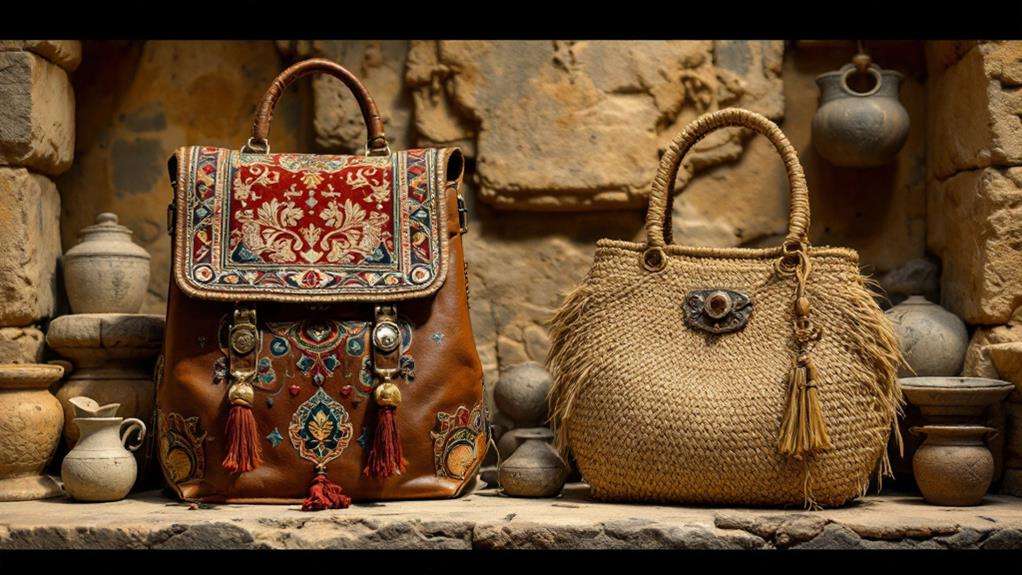
Ancient handbags, like time capsules, reveal a lot about the societies that created them. When you compare the Courtauld Bag to other ancient bags, you see a fascinating tapestry of history and craftsmanship. The Courtauld Bag, dating back to around 1300 A.D., is one of the earliest surviving examples of a woman's purse. It stands out not just for its antiquity but also for its intricate design, setting it apart from other ancient artifacts.
Take the Sutton Hoo purse cover, for example. Although it's an impressive artifact from around 625 CE, it's only a fragmentary piece compared to the complete and ornate Courtauld Bag. Meanwhile, in Germany, a 4,200-year-old purse fragment was uncovered, showcasing early functional bags. However, it lacks the artistry and preservation seen in the Courtauld Bag.
Even further back, Ötzi the Ice Man, who lived 5,300 years ago, carried a small handbag filled with tools. This shows practical usage similar to the Courtauld Bag but predates it greatly. Despite these fascinating finds, the Courtauld Bag's survival and craftsmanship truly illustrate the evolution of personal accessories across centuries.
Archaeological Insights
Exploring the intricate craftsmanship of the Courtauld Bag, you gain valuable archaeological insights into the Ilkhanate age. This oldest known handbag, dating back to 1300-1330 A.D., offers a rare glimpse into the artistic and cultural practices of the time. Crafted in Mosul, Iraq, its brass material inlaid with gold and silver reflects the age's advanced metalworking skills. The detailed court scene, complete with a rhyming Arabic inscription, provides a window into the social hierarchy and cultural nuances of the Ilkhanate age.
Archaeological finds like this handbag are rare, making its uncovering and preservation significant for several reasons:
- Cultural Representation: The depiction of a royal couple highlights social structures and gender roles, offering insights into historical cultural practices.
- Artistic Skill: The intricate metalwork and inlay techniques demonstrate the advanced craftsmanship and artistic expression prevalent during this age.
- Historical Context: As a complete artifact, it helps clarify historical misconceptions, such as its initial misidentification as a man's work basket or saddlebag.
Understanding the archaeological significance of this handbag helps you appreciate the historical context and value of such rare artifacts, shedding light on a bygone age's daily life and social customs.
Preservation and Exhibition
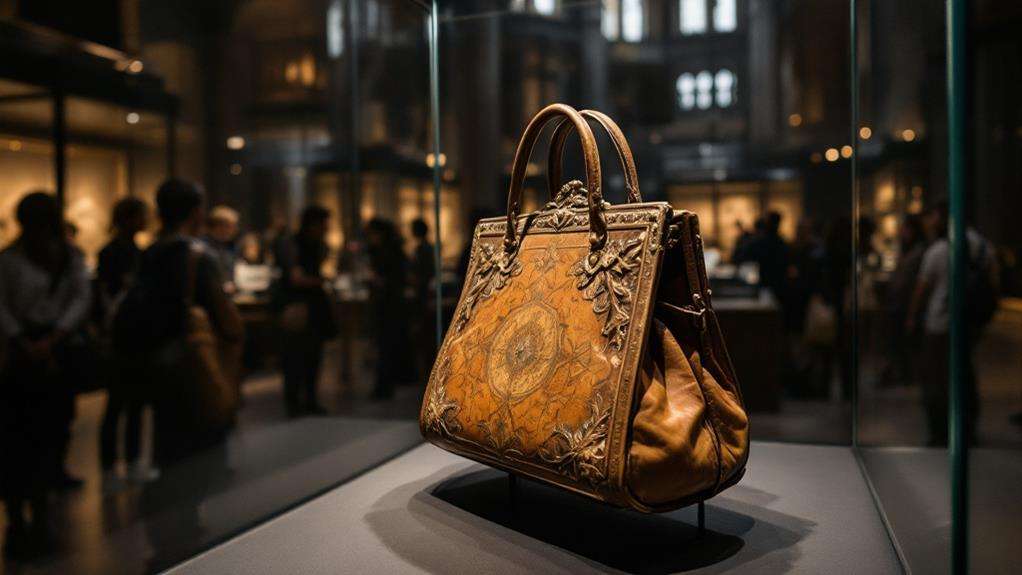
The Courtauld Institute of Art's careful preservation of the oldest known handbag guarantees that its historical and artistic significance isn't lost to time. This remarkable artifact, created in Mosul under Ilkhanate rule around 1300-1330, represents a piece of history that provides valuable insights into the period's craftsmanship and cultural influences. Its intricate design, featuring brass inlaid with gold and silver, showcases the artistic skills prevalent during the Mongol dynasty.
At the Courtauld Gallery, the handbag in the world was displayed until May 18, 2014. This exhibition, curated by Rachel Ward, allowed the public a rare glimpse into the daily life of a noblewoman from that time. Ward emphasized the handbag's relevance to women's history, highlighting its role as a significant artifact that connects us to the past.
Before its exhibition, the handbag was misidentified for years, underscoring the importance of scholarly documentation in preserving and understanding historical narratives. By recognizing its true significance, the Courtauld Institute of Art guarantees that this extraordinary piece remains a symbol of the rich cultural heritage of its time. Through their efforts, you can appreciate not only the handbag's beauty but also its place in history.
The Legacy of Early Handbags
This fascinating glimpse into the past reveals that early handbags were more than just utilitarian items; they were symbols of status and artistry. The oldest surviving handbag, dating back to 1300-1330 A.D. from Mosul, offers a unique window into the cultural significance of these accessories. Initially misunderstood as a man's work basket, its true identity as a woman's handbag was later recognized, showcasing shifting interpretations of historical artifacts. This brass handbag, intricately inlaid with gold and silver, is a demonstration of the craftsmanship of the time and the role of such items in societal hierarchies.
The legacy of this ancient handbag provides insights into the lifestyle and social standing of its likely owner, an Ilkhanid noblewoman. Its detailed court scene and Arabic inscription highlight its importance beyond mere function. Here's why this handbag holds cultural significance:
- Artistic Expression: The intricate designs reflect the high level of artistry and skill in Islamic art during the 14th century.
- Social Indicator: Its ownership by a noblewoman indicates the social roles and status of women in Mongol culture.
- Historical Insight: The handbag serves as a tangible connection to the past, offering clues about historical customs and daily life.

